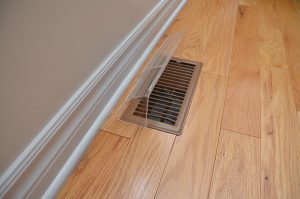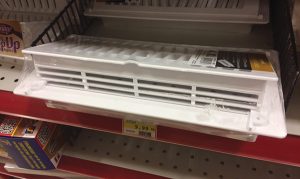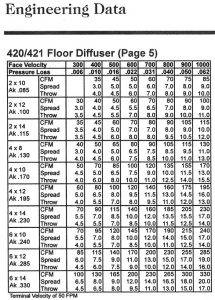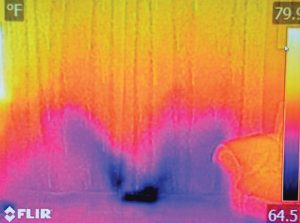
Whole house ducted HVAC: The end is near?
December 12, 2018 | By Ian McTeer
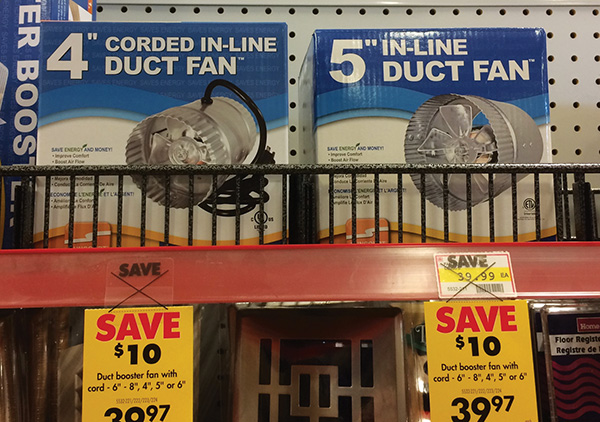
The heating aisle of any big box hardware store produces evidence that something is wrong with plenty of forced warm air heating and cooling systems.
Automotive analogies can be useful in explaining otherwise obscure HVAC concepts because many consumers of heating and air conditioning systems also have cars and understand the joys and sorrows associated with four-wheeled ownership. For example, suppose some car enthusiast purchased a Chevrolet Impala brand new in 1975.
Forty-three years later, let’s further suppose that the Impala is on its second engine using the latest computerized fuel management system. Regardless, it is still an obese, fuel guzzling beast that is going to require enormous amounts of cash and many hours of rework to bring it closer to today’s safety and emission standards. Better to simply buy a new car.
Similarly, a house purchased in 1975 may well be on its second or third HVAC system (engine), and it may have new windows and better insulation; however, the original duct system, designed for a furnace long since recycled into beverage cans, likely requires considerable renovation expense to suit today’s blowhard gas furnaces. Unlike the ’75 Impala, it is not so easy to run out and buy a better house.
SOMETHING IS WRONG
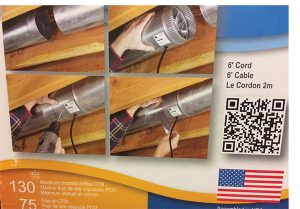 Snooping around in the heating aisle of any big box hardware store produces evidence that something is wrong with plenty of forced warm air heating and cooling systems.
Snooping around in the heating aisle of any big box hardware store produces evidence that something is wrong with plenty of forced warm air heating and cooling systems.
Why would any homeowner feel it necessary to purchase a duct booster fan or an adjustable floor register? It is obviously because they are not comfortable in one or more rooms of their poorly conditioned houses.
The manufacturer recommends the duct fan be installed within 10 feet of the register and be accessible for cleaning, not so easy if the room in question is the second floor master bedroom. Plus, the fan consumes 30 watts or more adding to the overall inefficiency of the system.
I have also seen a fan that sits on top of a floor register theoretically boosting air flow into the room.
Some homeowners believe directing airflow into the room away from the perimeter wall might lead to increased comfort.
HOW IS IT SUPPOSED TO WORK?
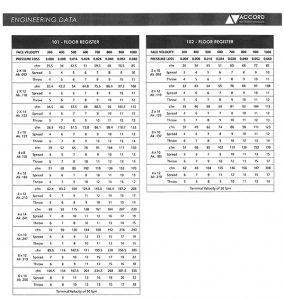 Typically, supply outlets are called “registers” because they give direction to the air. Return inlets are referred to as grilles because they simply cover the duct opening. Proper floor registers are engineered products referencing details such as air pressure drop, throw, noise levels and air mixture. Throw is the distance from the register that air movement can be detected and is related to pressure drop.
Typically, supply outlets are called “registers” because they give direction to the air. Return inlets are referred to as grilles because they simply cover the duct opening. Proper floor registers are engineered products referencing details such as air pressure drop, throw, noise levels and air mixture. Throw is the distance from the register that air movement can be detected and is related to pressure drop.
To what height should the air be thrown? When selecting a register, a minimum of eight feet of throw is needed for the best possible air mixing. Air mixing is essential to providing comfort, proper ventilation and reducing air stratification. Air mixing blends air that enters a room through infiltration, and helps to stabilize temperatures on surfaces that affect comfort.
Notice in the Accord Engineering Table (Figure 1) that 4 in. x 10 in. floor register Model 101, when supplied with 85 cfm of air, will throw that air nine feet. A Hart & Cooley Model 421 register (Figure 2) needs 85 cfm to throw the air eight feet. For a service technician investigating an alleged poorly performing heating system, the floor register data alone can be very helpful in determining why a particular room is uncomfortable.
The duct system distribution design should also allow for sufficient air changes per hour in order to maintain comfort.
Suppose, for example, a technician measures 85 cfm at each of three 4 in. x 10 in. registers in a master bedroom measuring 18 ft. x 24 ft. x 8 ft.
Using the formula:
Air Changes/hr = CFM x 60 minutes/Volume of the room
Thus,
255 cfm x 60 min/18 x 24 x 8 = 15300/3456 = 4.4 air changes per hour.
This is just barely enough air changes–typically a bedroom should have five to six air changes per hour. Two outlets should be balanced-up to 100 cfm each, improving the throw while providing better air changes for every hour the system fan runs.
STILL NO COMFORT
As discussed in HPAC October 2018, the dynamic two-storey residential building designs that enticed post war ticky tacky box owners to show-off their style have been particularly hard to air condition. It is not hard to find a homeowner sadly acquiescing to near no-go lack of comfort zones in their expensive houses. Here is an apt rule of thumb I learned long ago: if you can’t heat a room, you will never cool it. Poor cooling performance in second floor bedrooms is a constant complaint–even if a well-constructed, properly balanced air handling system is providing the numbers, too often customers complain about exaggerated temperature differences between the basement and the second floor.
Perhaps there are several other problems affecting both heating and cooling in the average home that cannot be readily reconciled by an HVAC technician. Here is a laundry list:
• Poorly insulated attic and walls causing the so-called flywheel effect that literally reheats the second floor after sundown
• Leaky windows or failed window units or windows left open
• Lack of shading on south facing windows
• Curtains or blinds left open during the day
• Doors/sliding doors unshaded and left open during the day
• Drapes, carpets or ceramic tiles blocking floor registers
• Furniture blocking registers and return air grilles
• Poor placement of registers and grilles
• Woefully inadequate return air especially from the second floor
• Decorative floor registers that provide no throw and create inadequate air mixing
• Handyman “adjustments” made to the air distribution system during renovations
• Irregular maintenance of HVAC equipment and filters
It seems that single zone forced warm air heating systems work best when the house is completely unoccupied. Once people and their possessions get in the way of throw and mixing, comfort and efficiency effectively disappear.
Typically, when the HVAC technician takes an airflow reading at a given register under a window, the floor length drapes are open and out of the way. A thermal image (Figure 3) shows what happens in cooling mode when the drapes are closed.
While the infrared camera cannot see the air, it can see the effect of the cool air and, in this case, too much air is being directed at the drapes. There is hardly any throw and not enough mixing. Eventually, the thermostat, located elsewhere, will be satisfied and this room will not be cooled satisfactorily.
THERE MUST BE A BETTER WAY
In his article, “Design Illiteracy: The Root of All Evil in Architecture” (www.healthyheating.com), Robert Bean explains that, “…air temperature in codes relates to the space or, more specifically, the space where the thermostat is located. This is not explicitly stated but when code compliance is cited the thermostat reading stands as witness.”
For many decades, houses built in Canada utilizing single-zone ducted forced warm air heating systems have been thermally victimized by the thermostat location, almost always found in the first-floor dining room or in a hallway directly across from a bathroom. There is no way that a smart thermostat, even if powered by IBM’s Watson brain and communicating with a remote sensor, can ensure the occupants of the master bedroom are comfortable at any given time.
How does an HVAC contractor sell efficiency and thermal comfort having firsthand knowledge about the inherent inefficiencies of yesterday’s duct systems? Also, homeowners are not interested in factual arguments offered by service technicians and sales people about moving furniture away from return air grilles or fitting shorter drapes in the interest of HVAC efficiency. Nor are consumers ready to spend thousands of extra dollars to renovate restrictive duct systems.
GO FREE DELIVERY
Any device that takes in air, conditions, and then discharges that air directly to the space without restrictive elements downstream is providing free air delivery. Ductless split systems leverage free delivery resulting in one of the best individual room comfort technologies available today.
When tied to a cold climate inverter driven heat pump, an indoor wall mounted air handler provides excellent air mix using a quiet but powerful tangential fan. Wall mounted units are designed to rapidly bring the room under control using a higher fan speed later reducing speed to provide a quiet maintenance air flow, drapes or furniture notwithstanding.
Manufacturers have developed several exclusive technologies aimed at keeping inhabitants comfortable without annoying drafts. Enhancements such as automatic swing dampers moving up/down and left/right or dispersing air through thousands of micro air holes once the fast cooling cycle has ended make free delivery room comfort vastly superior to forced warm air systems.
SMALL DUCT HIGH VELOCITY (SDHV)
Some manufacturers make incredibly versatile ducted systems running at higher static pressure, typically 1.5 in. w.c. Air is moved through a considerably smaller supply duct than used by conventional furnaces, often located in an attic although basement and alcove installations are possible. Conditioned air is delivered to the outlets through a 2 in. noise attenuated and insulated flexible tube. Air outlets are often placed in the ceiling about 5 in. from corners of the room.
Air is moved through the room using the principle of aspiration defined as: “the production of movement in a fluid by suction created by fluid velocity.” Aspiration, according to one manufacturer, “creates an even, draft free environment.” One such system utilizes a modular air handler that can work with chilled water, hydronic heat, any manufacturer’s outdoor cooling unit, or a matched inverter drive heat pump.
THE NEAR FUTURE
There seems to be some public interest in purchasing a net zero house sometime in the future whether by prescriptive government regulation or by sentimental attachment to our seemingly struggling environment. Net zero or zero energy buildings (ZEBs) produce as much or more energy than they need over the course of a year.
British Columbia recently unveiled its voluntary “step code” in which the province “has committed to taking incremental steps to increase energy-efficiency requirements in the BC Building Code to make buildings net-zero energy ready by 2032.”
Ontario’s Doug Tarry, of Doug Tarry Custom Homes promises a ZEB with, “no spaceship in the basement.” Tarry is committed to using “The Dettson Smart Ducting HVAC System, for smaller ducting, better air flow and greater occupant comfort.” How refreshing to see a builder devotes some of his expensive marketing space to bragging about comfortable customers and advanced HVAC technology.
What about all the potential HVAC customers living with their ungainly 1960s air distribution technology? Many of them have already replaced one or two gas furnaces and perhaps one or two cooling systems; yet, the master bedroom is still, at best, semi-habitable during weather extremes in far too many cases.
Again, ductless and SDHV offer an affordable way forward for those customers who are expending too much energy trying to be comfortable in their homes. Until such houses are completely renovated to possibly even ZEB standards, the old proverb wisely noting that you can’t make a silk purse out of a sow’s ear applies.
Unfortunately, any traditional forced warm air system capable of delivering all the advertised energy benefits can easily be handicapped by the occupant’s lifestyle. Therefore, it is important for HVAC sales people and service technicians to know all the work-arounds. Ask the comfort questions of your customers, but be sure you know when HVAC is going to get in their way. <>
Ian McTeer is an HVAC consultant with 35 years experience in the industry. He was most recently a field rep for Trane Canada DSO. McTeer is a refrigeration mechanic and Class 1 Gas technician.
To see ideas to improve whole house ducted HVAC performance see HPAC December digital edition, p20.

